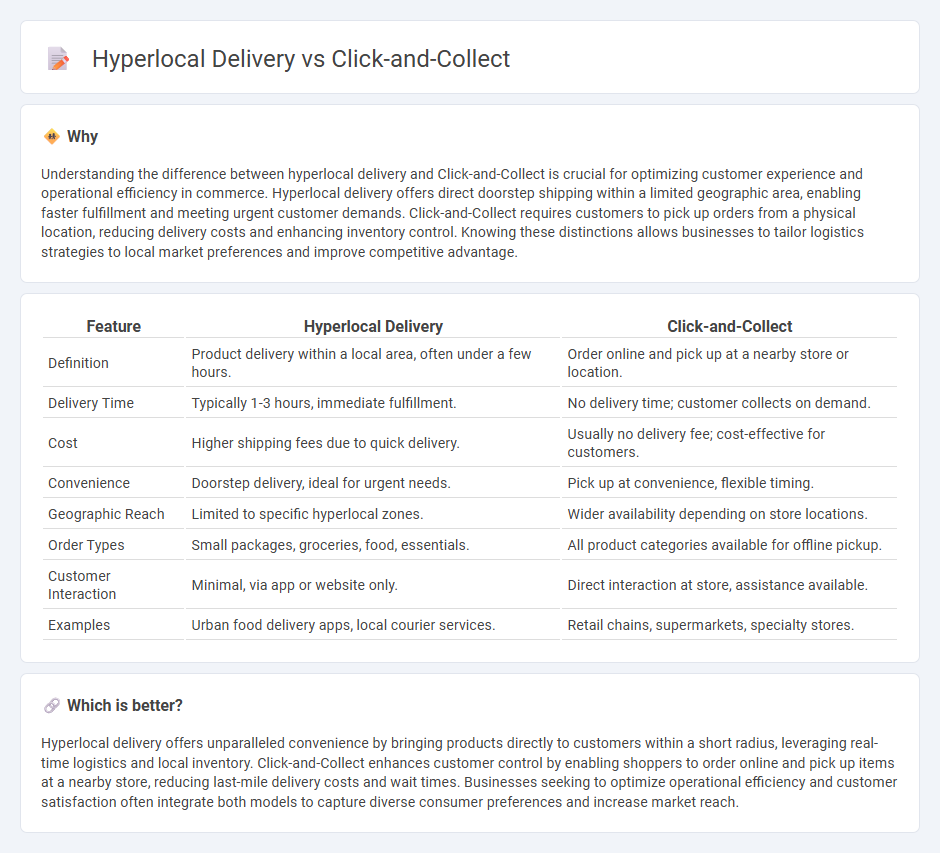
Hyperlocal delivery offers rapid, on-demand shipments within a limited geographic area, enhancing convenience for customers who need immediate access to products. Click-and-Collect combines online ordering with in-store pickup, reducing delivery costs and wait times while driving foot traffic to physical locations. Explore more to understand which fulfillment method best suits your business model.
Why it is important
Understanding the difference between hyperlocal delivery and Click-and-Collect is crucial for optimizing customer experience and operational efficiency in commerce. Hyperlocal delivery offers direct doorstep shipping within a limited geographic area, enabling faster fulfillment and meeting urgent customer demands. Click-and-Collect requires customers to pick up orders from a physical location, reducing delivery costs and enhancing inventory control. Knowing these distinctions allows businesses to tailor logistics strategies to local market preferences and improve competitive advantage.
Comparison Table
| Feature | Hyperlocal Delivery | Click-and-Collect |
|---|---|---|
| Definition | Product delivery within a local area, often under a few hours. | Order online and pick up at a nearby store or location. |
| Delivery Time | Typically 1-3 hours, immediate fulfillment. | No delivery time; customer collects on demand. |
| Cost | Higher shipping fees due to quick delivery. | Usually no delivery fee; cost-effective for customers. |
| Convenience | Doorstep delivery, ideal for urgent needs. | Pick up at convenience, flexible timing. |
| Geographic Reach | Limited to specific hyperlocal zones. | Wider availability depending on store locations. |
| Order Types | Small packages, groceries, food, essentials. | All product categories available for offline pickup. |
| Customer Interaction | Minimal, via app or website only. | Direct interaction at store, assistance available. |
| Examples | Urban food delivery apps, local courier services. | Retail chains, supermarkets, specialty stores. |
Which is better?
Hyperlocal delivery offers unparalleled convenience by bringing products directly to customers within a short radius, leveraging real-time logistics and local inventory. Click-and-Collect enhances customer control by enabling shoppers to order online and pick up items at a nearby store, reducing last-mile delivery costs and wait times. Businesses seeking to optimize operational efficiency and customer satisfaction often integrate both models to capture diverse consumer preferences and increase market reach.
Connection
Hyperlocal delivery and Click-and-Collect intersect by enhancing customer convenience and local commerce efficiency through proximity-based fulfillment models. Retailers leverage hyperlocal delivery to enable rapid shipments within a confined geographic area, while Click-and-Collect allows consumers to reserve items online and retrieve them in-store or at designated locations. Both strategies reduce last-mile delivery complexities, optimize inventory management, and improve overall customer satisfaction by blending online shopping with immediate local access.
Key Terms
Fulfillment Model
Click-and-Collect fulfillment models reduce last-mile delivery costs and increase customer convenience by enabling in-store pickup, while hyperlocal delivery offers rapid, often same-day delivery within a limited geographic radius to meet urgent demand. Click-and-Collect leverages existing store infrastructure for inventory management, whereas hyperlocal delivery depends on a robust local logistics network and real-time tracking for efficient fulfillment. Explore the key differences and benefits of each model to optimize your supply chain strategy.
Last-Mile Logistics
Click-and-Collect streamlines last-mile logistics by reducing delivery distances and consolidating customer pickups at designated locations, enhancing efficiency and cost savings for retailers. Hyperlocal delivery leverages real-time data and localized courier networks to expedite orders within narrow geographic areas, ensuring faster fulfillment and improved customer satisfaction. Explore in-depth insights to optimize your last-mile logistics strategy effectively.
Inventory Proximity
Inventory proximity plays a crucial role in both click-and-collect and hyperlocal delivery models, impacting fulfillment speed and customer satisfaction. Click-and-collect leverages nearby store inventory to enable in-store pickup, reducing last-mile delivery costs, while hyperlocal delivery operates through local warehouses or micro-fulfillment centers to expedite home delivery. Explore further to understand how optimizing inventory location boosts operational efficiency and customer experience.
Source and External Links
What is Click & Collect - How to Improve Retail Strategy? - Click-and-collect is a service where customers order items online and pick them up at a physical location, with two main models: in-store pickup (BOPIS) and third-party pickup points, giving customers control over time and place of collection.
What is Click & Collect? Benefits to retailers & consumers - Click & collect, also called buy online, pickup in-store (BOPIS), lets consumers order online and pick up in person, saving shipping costs and time, with options like lockers, in-store, and curbside pickup, becoming popular especially since 2020.
Click & Collect 101: What Is It and How Does It Work? - Click and collect involves ordering products online and either picking them up inside the store (BOPIS) or curbside, where store employees bring orders to the customer's vehicle, a service that gained popularity during the COVID-19 pandemic for convenience and safety.
 dowidth.com
dowidth.com